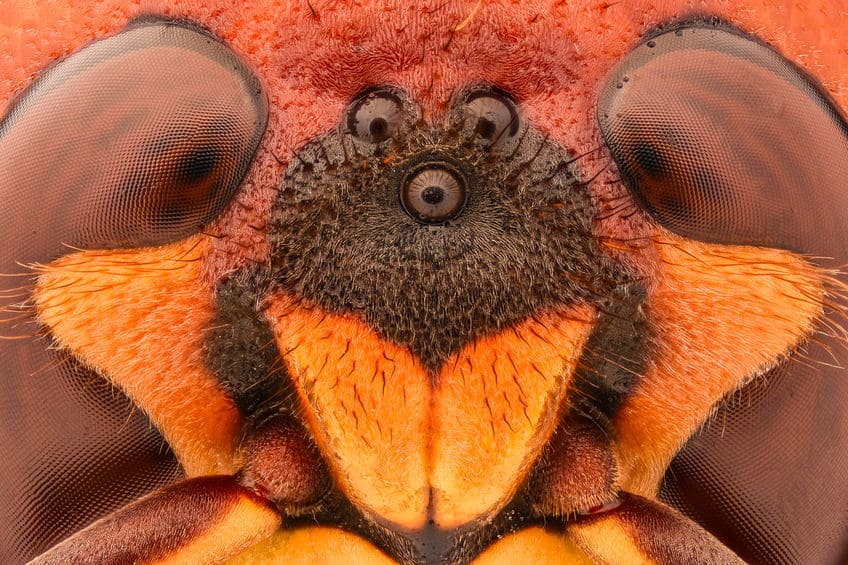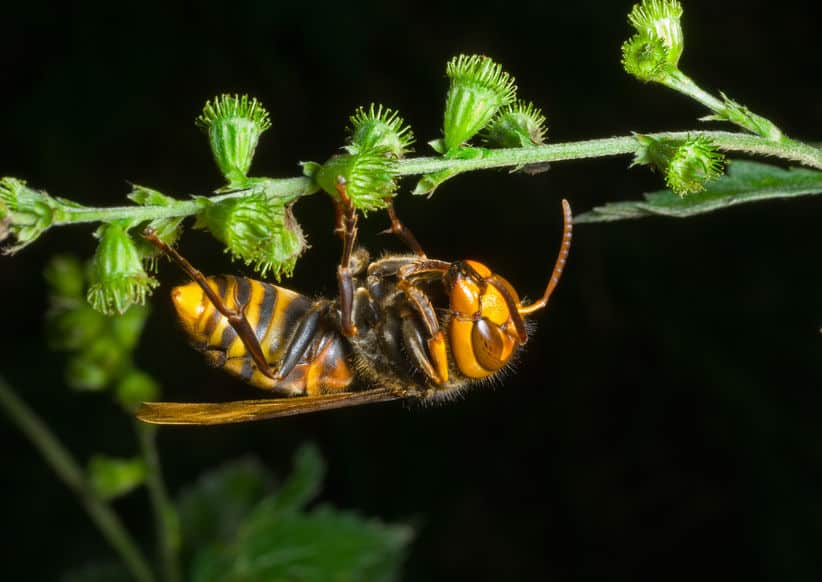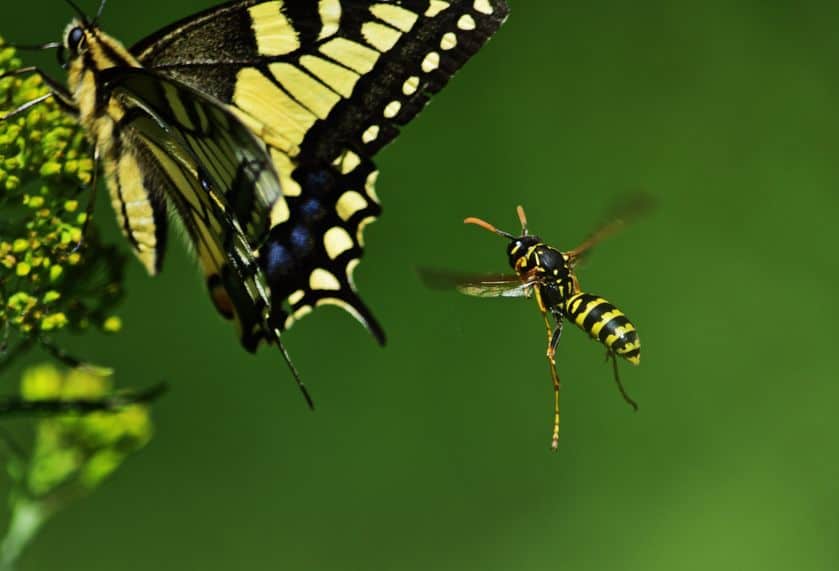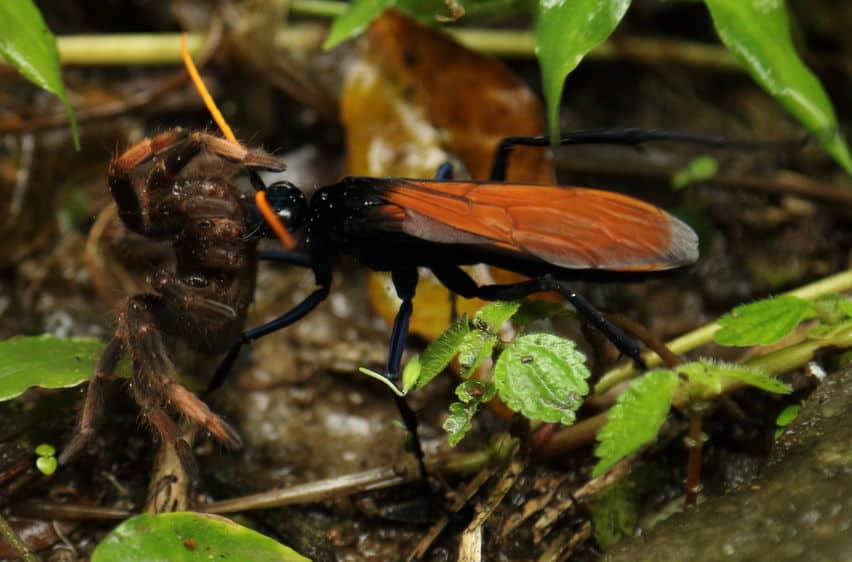Think you know wasps? See how many of these facts below you knew.
1. Male wasps can’t sting
Only female wasps can sting. The sting is part of the female reproductive organs. All-female wasps have these reproductive organs of which the sting is a part. The role of the male is only to mate with the queens and they have no hunting or defensive role.
Male wasps are pretty rare and short-lived so there is a chance you have never seen one. If you do find one it can be extremely difficult to tell them apart from females, and they even simulate stinging to fool potential predators into letting them go. Read more.

2.There is a wasp that hunts like a shark
A species of wasp discovered in Japan named the godzilla wasp has been found to attack its prey from underwater. These wasps have evolved to have long curved claws that enable them to swim. Its main prey is aquatic caterpillars. The caterpillars have hard outer shells that protect them from attack from above. Godzilla wasps, however, do not attack from above. They swim under the caterpillars and attack them from below the water. Read more.
3. Some wasps make honey
You might have thought that only bees made honey, but some wasps do too. The Mexican honey bee makes honey and in parts of Mexico, people consider it a delicacy. Read More.

4. Wasps shared the planet with dinosaurs
Wasps were on the planet with the most famous of the dinosaurs including the T-Rex. The fossil evidence shows that they existed as early as 240 million years ago. The evidence also suggests that many of these solitary wasps have barely changed during this time. A fossil of the cuckoo wasp from 99 million years ago shows it to have the same metallic green coloring as today. Read More.

5. Wasps can survive days without an oxygen supply
Amazingly it has been found that wasps and bees are so efficient at storing and using oxygen in their bodies that they can potentially survive for days with no new oxygen supply. When oxygen supplies are cut off wasps will go into a conservation state that shuts off unessential movement.
“They can shut down and survive for hours or days…If you compare Lance Armstrong, the bee, and the hummingbird, the bee is the champion of oxygen delivery“
phys.org
6. There are wasps that turn cockroaches into zombies
Cockroach wasps don’t just prey on cockroaches, but they even take over control of their movement. The cockroaches that these wasps want are much bigger than themselves, so they have developed a way to control the cockroach’s every move. They sting the cockroach not once, but twice. The first sting momentarily paralyzes the wasp. The second sting aimed at a specific place in the roach’s head disables its ability to send messages to move its legs. From now on the cockroach is at the mercy of the wasp, which is walked by its antennae back to the wasp’s nest where it will become living food for the wasp larvae. Read more.

7. The tarantula hawk has the most painful sting
According to the Schmidt insect pain index, the tarantula hawk ranks as the most painful wasp sting, “Blinding fierce, shockingly electric. A running hair dryer has been dropped into your bubble bath. A bolt out of the heavens. Lie down and scream.” Known as the man of 1000 stings Schmidt has compiled a list of the insects with the most painful stings. Read More.

8. Wasps gave inspiration to the invention of paper
Wasps were making paper to build their nests millions of years before we humans existed. Perhaps unsurprisingly these wasp habits are thought to have given inspiration to people. Paper was first invented for use by people in China around 100 AD, but not manufactured in Europe until 1144 AD.
Wasps scrape wood from trees and other sources and then chew it before depositing and shaping the wood pulp to make their intricate nests, a feat of engineering in themselves. Read more.

9. Some wasps can spray venom
In his book, The Sting Of The Wild, Justin O. Schmidt recounts his discovery that some wasps can indeed spray venom. Known as the man of 1000 stings he has created an insect pain index. During his research he came across the parachartergus fraternus, a black wasp found in Costa Rica. He describes how when attempting to take their nest for research he was met with a spray of venom. Read more
“They sprayed streams of venom through the veil directly at my eyes.”
Schmidt
10. Murder hornets are a snack in Japan
People in Kushihara and the surrounding area like to eat fried murder hornets for a snack. The larvae of the hebo wasp are also considered a delicacy. So much so that people even hunt for a nest in the wild and take it home to farm the colony for its larvae. The person with the heaviest wasp nest at the end of the season even wins a prize at the annual Hebo Matsuri Wasp festival. Read More.
11. Wasps have 5 eyes
You’ve probably seen those two big compound eyes on a wasp, but have you seen the 3 small simple eyes that they have between them. They are so small to us, they just look like small black dots. They are quite useful for a wasp as they help them see light and dark. Read More.

12. Murder hornets can kill a hive of honey bees in as little as two hours
Murder hornets are not only the largest social wasps on the planet, but they also prey on honey bees. These wasps will attack a hive to get to the wasp brood and honey. They methodically decapitate the honey bees before raiding the hive. Read More.

13. Queen wasps often hibernate in houses
Queen wasps will hibernate in areas that protect them from freezing temperatures. This includes cracks in building structures, within trees, and in woodpiles. Houses obviously appeal due to their insolation and warmth. If a queen has been attracted to hibernate within a house this could potentially be problematic if she later decides to build her nest within the same vicinity. During hibernation, the queen tucks her wings up around her body for protection. It is possible that you have a queen in your house and you don’t even know it.
14. Wasps can fly up to 25 mph (40 kph)
It seems wasps can fly pretty fast. The Asian giant hornet has been clocked at 25 mph, and the yellow-jacket not much slower. So, next time you think you can outrun a wasp you might think twice.

15. Most wasps can only consume liquid food
Wasps have tube-like mouthparts that are used for sucking their foods known as a proboscis. That’s why wasps are especially attracted to sugary drinks. Wasps can suck body fluids from their prey.
Wasp larvae need protein and eat meat brought to them by worker wasps. The wasps hunt and kill other insects such as bees, caterpillars, and flies.
Wasps will use their mandibles to cut small pieces of meat from our food if the opportunity presents itself. The adult wasps can not eat this solid food but the wasp larvae will. Read more.
16. Queen wasps and solitary females can decide the sex of their offspring
Fascinatingly queen wasps can actually select whether an egg will be a male or female. The sperm from the male wasps are stored in the queen and she then can choose whether to produce an egg inseminated with the sperm or not. An egg not inseminated will become a male wasp. Read more.
17. Many wasps paralyze an animal to serve as food for their offspring
Many solitary wasps are parasitoids, meaning they use other animals to provide food for their offspring. One such example is the tarantula hawk
The tarantula hawk targets tarantulas. They will sting the tarantula and paralyze them with strong venom. Once paralyzed the wasp will move the spider, still alive, to its nest. Once there the wasp lays a single egg on the spider. The egg will hatch and develop into larvae that will gradually feast on the inside of the paralyzed spider.
What makes this even more disturbing is that they have evolved to spare the spider’s vital organs for last to keep the spider alive for as long as possible to prevent any decay from occurring. Read more.

18. Wasps can fly backwards
Wasps can indeed fly backward with research showing that wasps will fly backward when leaving their nest in order to build up a picture of the return view. This ensures they don’t get lost on the way back to the nest. Read More.

19. The European honey buzzard can sedate wasps
Despite its name, there is nothing the European honey buzzard likes to eat more than wasp larvae. For the bird, this means raiding wasp nests. These birds have chemicals on their feathers that have a sedative effect on the wasps. This makes it possible for the bird to eat its way through all the larvae in a wasp nest, leaving the nest in pieces. Read More.

20. Peppermint repels wasps
It turns out that there are a number of essential oils that wasps really don’t like, including peppermint. Spraying a mixture of peppermint oil, water and soap could do wonders for keeping wasps away. Read More.

